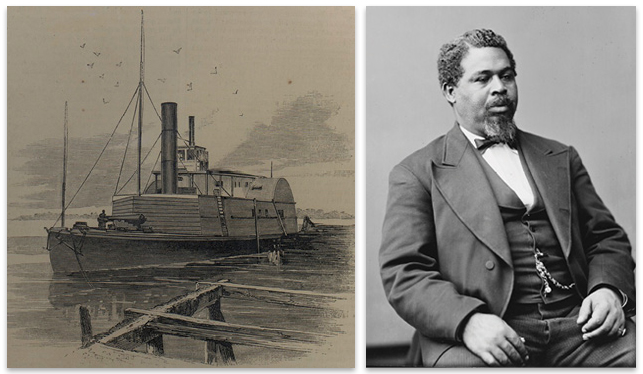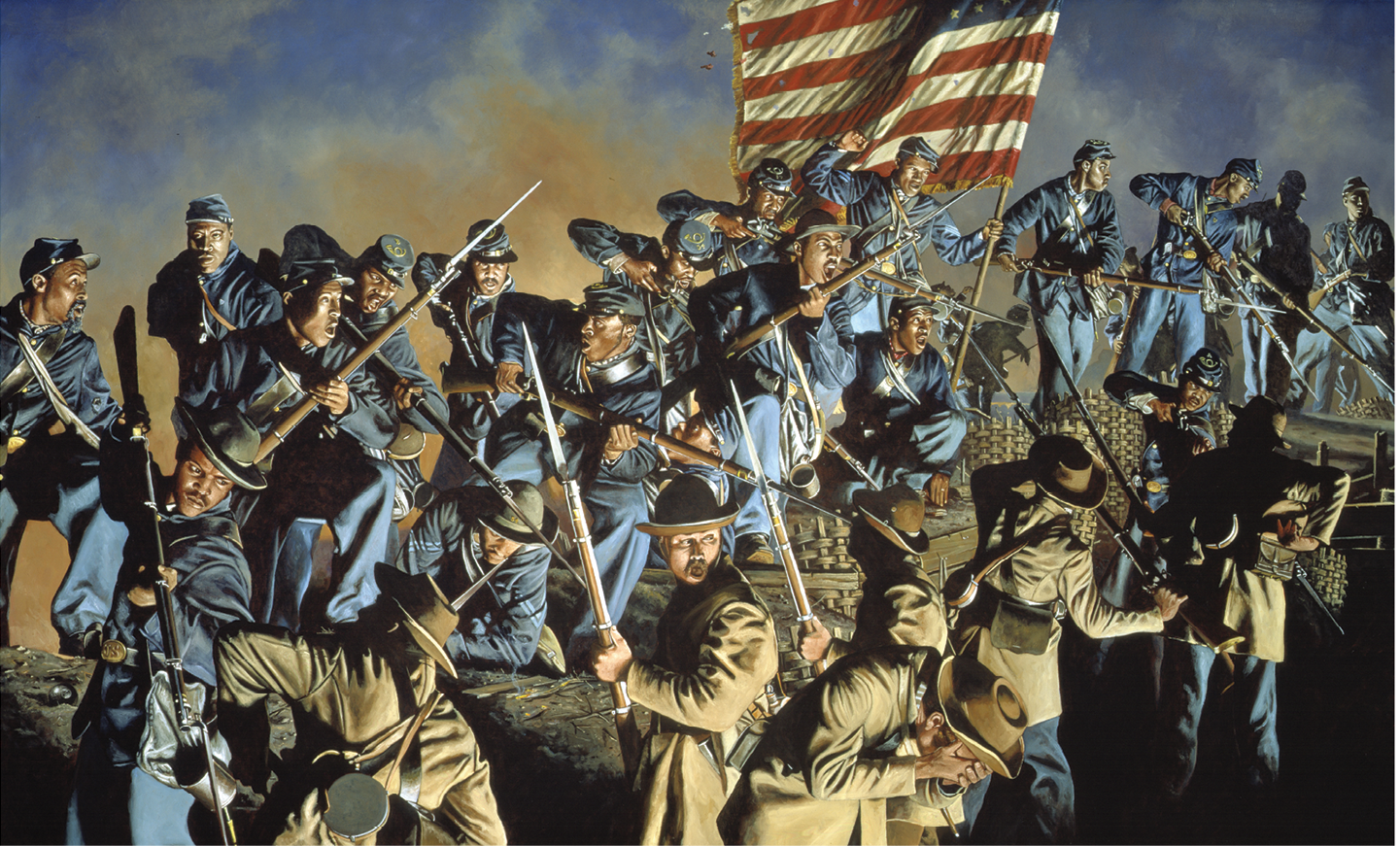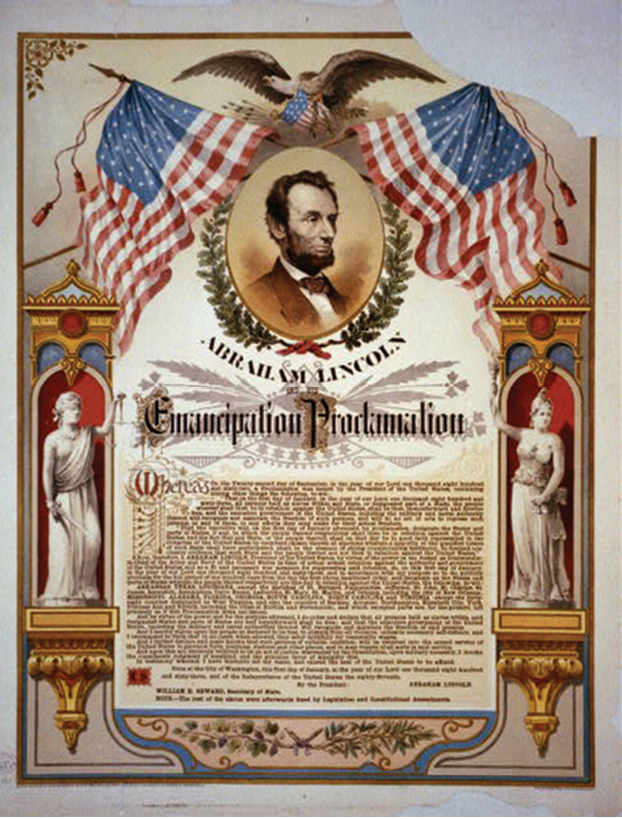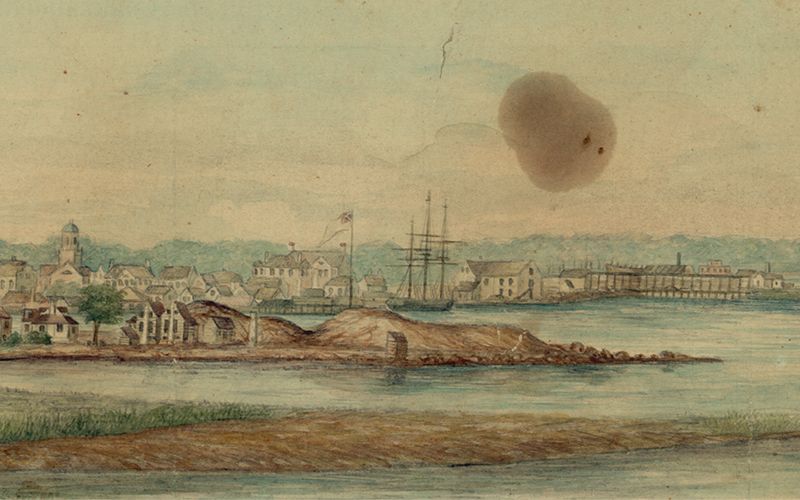View of Charleston from Fort Wagner on Morris Island (courtesy Library of Congress)
- 1860: Democratic Convention Collapses - From April 23 to May 3, the Democratic National Convention meets at South Carolina Institute Hall and battles over whether slavery should be legal. Southern delegates march out in protest, making a quorum to nominate a presidential candidate impossible, and a Civil War draws a step closer. The Democratic Convention has never returned to Charleston.

Imprint of the South Carolina Declaration of Secession, appearing on December 20, 1860 in the Charleston Mercury, a secessionist newspaper founded by Henry L. Pinckney in 1819 (courtesy of WIkipedia)
- 1860: Ordinance of Secession Passes - Five days before Christmas, delegates meeting in Charleston vote to make South Carolina the first of 11 Southern states to leave the Union. The event precipitates the deadliest war in American history.

Top: Two cannons guarding the Battery in 1863 (courtesy of Library of Congress)
- 1861: Fort Sumter Attacked - Before dawn on April 12, Confederates open fire on Union-held Fort Sumter in Charleston Harbor. After 34 hours of horrific and incessant bombardment, Union forces under the command of Major Robert Anderson surrender. With this battle, the Civil War begins. Not one soldier dies during the two-day bombardment, yet the four-year-long war that ensues claims some 620,000 lives.
- 1861: Fire Consumes the City - On December 11, a fire breaks out at East Bay and Hasell streets. Carried by the wind, it spreads to Council Street at the Ashley River. The most damaging conflagration in the city’s history, it destroys “600 houses, including every public building in the city, and property valued at $7,000,000,” according to Harper’s Weekly, December 28, 1861.

Robert Smalls and his crew take the gunboat CSS Planter out of the harbor and turn it over to the Union Navy in exchange for their freedom. (Courtesy of Library of Congress)
- 1862: Robert Smalls Commandeers the CSS Planter - On May 13, after the Confederate officers have gone ashore for the night, the ship’s enslaved pilot, Robert Smalls, and the all-black crew make a run for the Union ships outside the harbor. Picking up their relatives at a nearby wharf, they slip past Fort Sumter and turn the Planter over to the Union Navy. In honor of this daring escape, Smalls is made ship captain. He later serves in both the SC State legislature and the US House of Representatives.

The Old Flag Never Touched the Ground (1863) by Rick Reeves, depicting the 54th Massachusetts attacks Fort Wagner (courtesy of Wikimedia Commons/The National Guard)
- 1863: 54th Massachusetts Assaults Battery Wagner - The black volunteer infantry leads an attack against Confederate troops on Morris Island on July 18. Though they suffer nearly 50 percent casualties, they prove the mettle of African American soldiers. “The 54th did well and nobly...and with their enthusiasm they deserved a better fate,” writes New York Tribune correspondent Edward L. Pierce to Massachusetts Governor John A. Andrew on July 22, 1863. Read on about the 54th Massachusetts.

A pen-and-ink and watercolor map of the city of Charleston in 1864, marked with Confederate fortifications along the Ashley and Cooper rivers and areas burned as a result of Union shelling
(courtesy of Library of Congress)
- 1864: CSS Hunley Lost - With a crew of eight and a 135-pound torpedo attached to a spar at her bow, the Confederate submarine CSS Horace L. Hunley leaves Breach Inlet on the bone-chilling night of February 17 and successfully rams the USS Housatonic anchored offshore, planting the torpedo into the warship. Five sailors on board die, and the Housatonic sinks almost immediately. The Hunley also mysteriously sinks, killing the entire crew, but her actions mark the first time in history a submarine sinks an enemy ship. Get more facts about the Confederate submarine.

(Courtesy Strobridge & Co. Lith./Library of Congress)
- 1865: Emancipation Celebrated - Though President Abraham Lincoln’s history-changing order was announced two years prior, the Emancipation Proclamation is read in Charleston on March 21 as the climax to a 2.5-mile parade with thousands of newly freed African Americans in attendance. Fearing an uprising, the majority of white citizens hide indoors.
- 1865: Francis Cardozo Founds the Avery Normal Institute - The Avery Normal Institute opens on May 7 on Bull Street with a mission to educate recently freed slaves. For nearly a century, it produces noted business, religious, educational, and civil rights leaders. The building continues its legacy as the Avery Research Center for African American History and Culture at the College of Charleston, with a mission to “collect, preserve, and promote the unique history and culture of the African diaspora, with an emphasis on Charleston, the South Carolina Lowcountry, and beyond.”
- 1867: Phosphate Mining Emerges - Entrepreneurs begin mining phosphate, helping the city recover from the financial hardship of the war and diversifying the economy that is dominated by agriculture.
- 1868: New State Constitution Adopted - The new South Carolina Constitution is adopted at a convention in Charleston. Two-thirds of the delegates are African Americans, some of whom were enslaved less than five years earlier. This first document, which provides for public education and abolishes property ownership as a qualification for holding office, will be voided by the end of Reconstruction.
- 1877: Reconstruction Ends in South Carolina - On April 3, newly elected President Rutherford B. Hayes orders the withdrawal of Federal troops from South Carolina, effectively ending the bitterly controversial period of Reconstruction in the state. Conditions for African Americans, however, return largely to antebellum status quo.






